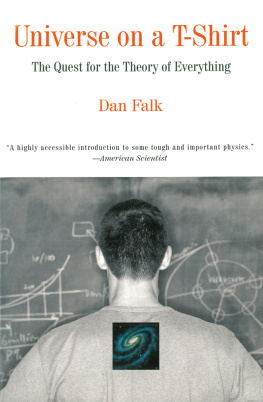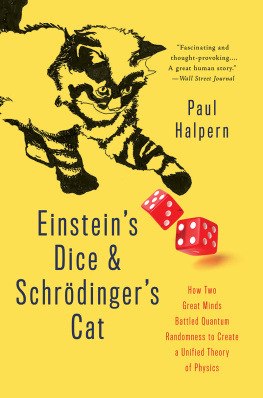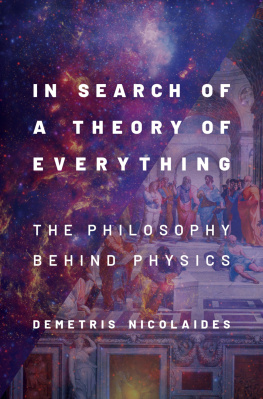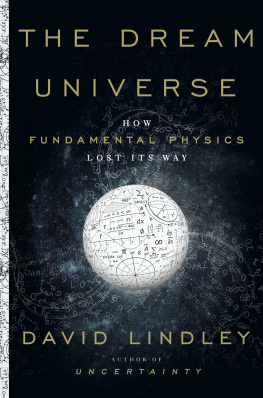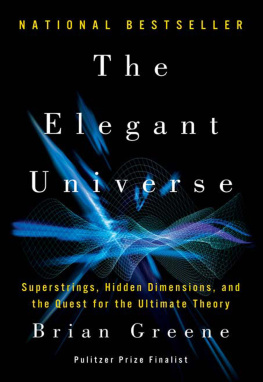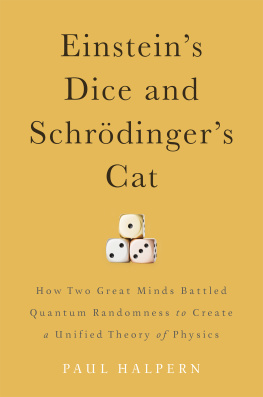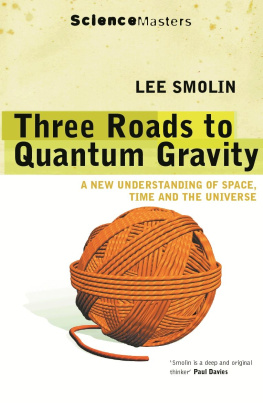Universe on a T-Shirt
Universe on a T-Shirt
The Quest for the Theory of Everything
Dan Falk

ARCADE PUBLISHING NEW YORK
Copyright 2002, 2013 by Dan Falk
All Rights Reserved. No part of this book may be reproduced in any manner without the express written consent of the publisher, except in the case of brief excerpts in critical reviews or articles. All inquiries should be addressed to Arcade Publishing, 307 West 36th Street, 11th Floor, New York, NY 10018.
FIRST U.S. EDITION 2004
First published in Canada by the Penguin Group
Quotation from The Atom in the History Thought by Bernard Pullman (Oxford University Press 1998) is used courtesy of the publisher.
Arcade Publishing books may be purchased in bulk at special discounts for sales promotion, corporate gifts, fund-raising, or educational purposes. Special editions can also be created to specifications. For details, contact the Special Sales Department, Arcade Publishing, 307 West 36th Street, 11th Floor, New York, NY 10018 or arcade@skyhorsepublishing.com.
Arcade Publishing is a registered trademark of Skyhorse Publishing, Inc., a Delaware corporation.
Visit our website at www.arcadepub.com.
10 9 8 7 6 5 4 3 2 1
Library of Congress Cataloging-in-Publication Data is available on file. ISBN: 978-1-61145-793-3
Printed in the United States of America
For my parents
Contents
Acknowledgments
Ive always been interested in astronomy, physics, and the universe, but my passion for string theory blossomed after attending two conferences in Chicago in December 1996. One was held in memory of the Indian-born astrophysicist Subrahmanyan Chandrasekhar, and drew such luminaries as Stephen Hawking and Edward Witten. The other was the Texas Symposium on Relativistic Astrophysics, which, despite its name, is not always held in Texas. Since then Ive become a bit of a science-conference junkie, attending symposiums and workshops across North America and becoming something of a regular at meetings of the American Astronomical Society and the American Physical Society. Stephen Maran, who handles media inquiries for the AAS, and Phil Schewe, who does the same for the APS, have given me numerous tips and contacts and answered hundreds of questions over the years.
My first major investigation of the themes in this book was carried out in 1997, when I put together a documentary called From Empedocles to Einstein for the CBC Radio program Ideas. That show was produced by Richard Handler, who helped focus many of my ideas. From that point onward, I had thought about writing a bookbut the plan only crystallized after I got an e-mail from Jennifer MacTaggart of Penguin Canada. Susan Folkins later helped steer meand the bookin the right direction. I am also indebted to Rosemary Tanner for her tireless and invaluable help in editing the final manuscript, and to Joel Gladstone for his production editorial skills.
Dozens of scientists and historians answered countless questions and, in some cases, agreed to look over portions of the manuscript; particularly helpful were the physicists Pekka Sinervo, Amanda Peet, Glenn Starkman, John Schwarz, and Michael Duff. Lengthy interviews with Edward Witten, Leon Lederman, Paul Davies, and John Barrow, which formed the heart of my Ideas documentary, also bring life to these chapters. On the humanities side, I benefited greatly from discussions with John Traill, Alexander Jones, James Robert Brown, and Dennis Richard Danielson. Owen Gingerich, an astronomer and historian of science, patiently granted interviews and responded to my numerous e-mail queries, while science writer Marcus Chown generously read several chapters. No doubt some errors remain; they are, of course, purely my responsibility.

Note to the Reader
Although Ive tried to keep this book non-technical, there are occasions when distances, times, and other measurements come up. I have used metric units for distances, but those who are more familiar with Imperial units shouldnt be put off. A kilometer is a bit more than half a mile; a centimeter is a bit less than half an inch, and a millimeter is one-tenth of a centimeter.
In astronomy and cosmology, much larger distances arise and we must switch to light-years. One light-yearthe distance light travels in one yearis about 9500 billion kilometers or about 6000 billion miles.
Occasionally, we will also encounter very large or very small numbers. With large numbers, one can pile on strings of zeroes or refer to so many billion billionsbut this soon becomes rather cumbersome; with small numbers (billionths of billionths), things become even uglier. The graceful solution, adopted by scientists everywhere, is to use scientific notation. Using this system, any number can be expressed as a power of ten. With large numbers, an exponent stands for the number of zeroes. For example:
one hundred = 100 = 102
ten thousand = 10,000 = 104
one billion = 1,000,000,000 = 109
and so on. With small numbers, the exponent becomes negative:
one hundredth = 1/100 = 10-2
one ten-thousandth = 1/10,000 = 10-4
one billionth = 1/1,000,000,000 = 10-9
Introduction
My ambition is to live to see all of physics reduced to a formula so elegant and simple that it will fit easily on the front of a T-shirt.
LEON LEDERMAN
The longed-for Theory of Everything promises to provide the final discovery after which all physics will become the refinement of its content, the simplification of its explanation....
Eventually, it will appear on T-shirts.
JOHN D. BARROW
T he universe explained. Not a long-winded, highly technical explanation, but one that is concise, simple, and elegant. The Theory of Everything will explain the physical world we see around uspeople and planets, cars and comets, sand and stars. It will explain the origin of everything in our universe, and describe its most basic components. And while it will likely be expressed through abstract mathematics, the ideas at the heart of the theory may turn out to be extremely simpleso simple, in fact, that the essence of the theory can be written on a T-shirt. This remarkable goal, suggested by the quotes on the preceding page from leading physicists on both sides of the Atlantic, sounds like a fantasy, something dreamed up after the Friday afternoon bull session moved from the faculty lounge to the local pub. Yet it is not a proposition made on a whim. It is a bold but very logical ideaa natural extension of what every physicist does every day. What theyve been doing, in fact, since the dawn of science.
In the chapters to come, well explore this quest for simplicity in detail, tracing its evolution from ancient times, through the Scientific Revolution, to the provocative ideas of modern cosmology and particle physics. Lets start, however, not with history or with physics, but with a riddle. Youre looking at a house across the street. You see a doctor enter, then a lawyer, and finally a priest. What is happening in that home? Before reading any further, take a moment to see if you can solve the riddle.

You probably figured out that the occupant of the house is terminally ill. First comes the doctor, who makes the diagnosis; then the lawyer, to settle the estate; and finally the priest, to administer last rites. Whats so appealing about that solution, of course, is that its so simple, so incredibly logical.

